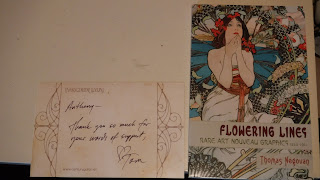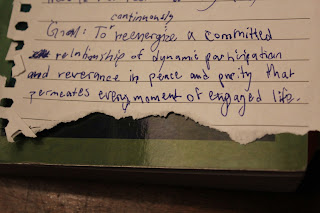I doubt a lot. I doubt myself, my work, my path, my environment, my ideas, my contradictory thoughts, actions and just a whole bunch of stuff. I doubt people. All that I doubt in myself, I project doubt onto them about these things too. I doubt my projections. I doubt life itself, and I had for a moment a thought during meditation that maybe this doubt isn't so bad 'after all.' I doubt this too, a little.
I've found that certain things become more credible for me as tools to navigate life with as I use them and understand what their place is for me within the universal impersonal changes in life. Some of the things for me right now are practices. One is art (drawing and painting), one is dance (Mandala Movement), one is Qi-Gong and one is Vipassana Meditation as taught by S. N. Goenka. Another one is writing this weekly blog post and making a monthly Youtube video. And of course the last one, but not the least, is working on my story, (secret title.)
Richard Feymann had commented once that doubt is a key component of his personality and who he is. Science requires doubt, so that we can test our theories, know whether we're right or wrong and then start again. Without doubt, we could stop any scientific exploration and live as we are. That is the feeling I had during meditation, that doubt is the other side of the coin of exploration and creative invention. Doubt is the yin to consistent curiosity and exploration as yang. Of course, I doubt this when I state it as an intellectual point. I don't doubt it in the experience I have of it. The 'intuition' of it, one might say, but I'd actually rather not say anything like that either.

What my practices do for 'me' is bring me into the direct experience of something that has no doubt whatsoever. In hindsight, in my intellectual activity, I may look at it and doubt it. I may not understand it fully in words and theories. These full living experiences are not always result oriented and cannot 'always' have the 1+1=2 literacy. In a day to day existence, I can't say what does what in terms of cause and effect. I can have guesses, but it won't be one hundred percent accurate. When I'm practicing Vipassana meditation, I can experience this shifting take place without a measurement. It is undeniable, direct, choice-less awareness of reality. It's hard to put words here, because I feel when I say 'reality,' someone can say that that is a subjective 'idea.' It is NOT when you are experiencing it directly, which may be a bit paradoxical, or simply unable to be proven right or wrong, true or false.
It is unable to be truly calculated and one might call that insanity, but too much calculation is actual insanity. This analysis mindset breaks spontaneity, poetry, intuition, faith and experience. Attention is caring and the action required to live objectively. It is attention that we can rely on first, because otherwise any new discoveries will be based on old thought. Doubt can be a deep, fulfilling component to realizations and their explanations. Doubt gives us the courage to go into uncharted territory and come back with something to share, when we understand that doubt is our tool for growth. Too much doubt, on one hand, can be just like too much calculation. We think we know and therefore we get the results we've 'set in stone.' For example, my recent arm injury has become very clearly a direct representation of my mindset for approaching my artwork. A mindset that is detrimental and short-sighted. See the picture below. These examples may shine all around us when we know how to see them. We are also free to doubt them, but sometimes they deserve the credit for being so blatantly obvious, in hindsight.

~This says, "I have to get better" (at art - mental) on one side, changing into "I have to get better" (with my arm injury - physical). A direct translation, just a different context showed up because I needed to learn the lesson all the same and change my thoughts about myself. The thing didn't matter, just the application of it and thankfully I had the context change enough to show me what I wasn't noticing. 'Enjoying my pain,' because it helped me see.~
I was thinking about food and how someone might be a good chef. Their food is good, so we want them to cook and we want to eat their food. This is how we think, yet at another level, gratitude can change the quality of the experience of any food so drastically that we don't need to get someone good to cook, in a way. As I write this, I'm bouncing around my memories of Jim and Andy, a movie with Jim Carrey going into how he acted as Andy Kaufman in 'Man on the Moon.' He experienced something surreal with this performance and permeated it into the cast and the process of making the film. He doesn't fully understand it in all its levels, but it came together none the less and the movie was well made within that chaotic, emotional state of transformation and questioning. All context can be tools for this transforming and our transforming can give all context validity. Seeing representations of things can help us to put our observations in perspective, and help us observe more.
Other examples coming to mind are when the first picture of Earth was taken from the space station. The observation of the wholeness of Earth and how that's our home changed the perspectives of many people. The picture represented that and helped us see it. The other day I had not done something that I felt would have been fun. I reacted, thought too much about it and fell into a fearful stasis. Right after, my jacket strings got tangled in a mess and were tangled around my neck and head as I put the jacket on. I was like, "What's going on?!" The strings were choking me, as I had choked. I had to take my jacket off and work to untie the knot. Being a bit frustrated as I untied it, I stopped. I took a breath and thought, "this is a representation of the fear I just experienced. When I untie this knot, I'm untying that fearful patterning I just experienced." After that thought, the untying was easy, as if I was just aligning with what the truth of the situation was. The energy of that activity was no longer about finishing it, but about knowing what it represented. Here's some tangled headphones, which I can untie using that same mentality of processing, contrary to frustration.

When thinking about the value of meditation and the free mind that acts without pretense and with a freshness of creative insight sometimes beyond logical, comprehensive calculation, I found that it is in certain practices that I experience this knowing. With Qi-Gong, Vipassana, Mandala Movement, I am more 'with' the experiencing of it than anything else. "How can I even be anywhere else?" One imagines. It is with thought that I can identify with things that are projections and therefore feel elsewhere. I am not aligned with what I'm doing at the intimate feeling level and the total understanding of it through a direct, objective, universal awareness. I know the difference when I'm with that or living in ideas and projections. When I'm not IN it, or WITH it, then I am in a division between an idea or image of myself, other labelled things, and the perception of what is here and now. Basically, process V.S. result, but being totally with something can still lead to tremendous results, such as in Andy Kaufman's (or Jim Carrey's?) 'Man on the Moon,' and also in life itself. This doesn't just happen in the movies folks.
We come to think that we are finished human beings, that we won't change any more. There's a study that talks about how people think they would still like to see their current favorite band ten years from now, and pay more money to see them. Yet, most of them wouldn't care to see the band that was their favorite ten years ago, today. This is our choosing to find that perfect chef, because he's what we think we want. When I'm truly present, I don't need anything. It's just like Jim Carrey says at the end of Jim and Andy, "I have no ambition." I am living life, when I'm living it, so what else could I possibly ask for? MORE than everything that my experience is? How can that be reached? This is the kind of 'new' common sense that I integrate into my psyche with every moment that I'm in creative process mode and not in quick, efficient result mode. I am understanding the balance and the connection of these two modes (as I doubt if they are separate) more and more.
What I get from my weekly, daily, monthly practices is a sense that what I'm doing all the time, no matter what the thing is, is more like a practice of moving energy, such as Qi-Gong, or watching my energy move, such as Vipassana. In typing this, I can write it as if I'm doing a Mandala Movement 'dance' and move in a natural, flowing way. I can feel as though there is a lightness in my work because I'm just playing with waves, trees and movements in the body. I can experience an effortless witnessing of these things that require a focus to come into fruition and yet not lose a clarity of boundless attention that it is aware of all passing, changing movements in freedom. Of course, I doubt my clearly stated words when I know in my experience I bounce around in my thoughts like a lunatic sometimes, but so did Jim Carrey as Andy Kaufman. I may sometimes be doubting or losing the battle against myself, or battling myself (and therefore losing), or just simply not too sure about what it is I should do, until I sit and get so engaged with reality that I don't miss a thing. Therefore, I continue to rest, return and continue, on all levels of my experience with what is.
Thanks for reading,
If you like this, please share and continue coming back every Sunday for a new post.



































